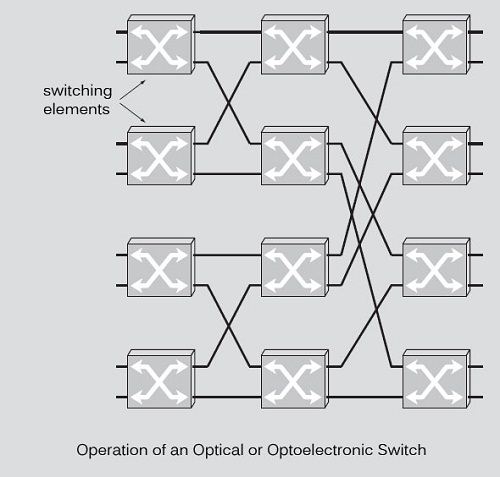The Optical Switches are used to connect optical links between them. At incoming optical fibers correspond outgoing optical fibers. If the switch uses an electrical part, the switch is said opto electronics and not only optical. These switches are based on the interconnection of switching elements, that is to say, switches which have two input gates and two output ports as shown in Figure. Connected in series, these elementary switches allow making great switches. The design of these devices, however, poses many problems.

These switches, or MIN (Multistage Interconnection Network), can be of two types: either the signal is converted into an electrical signal or the optical signal is switched. In the second category, there are the following two techniques:
• Control and routing decisions made electrically;
• All-optical switching.
Circuit switching remains easier to implement than the packet, control and routing decisions being much simpler in this case. In a packet switching, the arrival of each packet, take decisions more control and routing, which require several hundred picoseconds in the best case. Currently, potential collisions can handle optical signals when a crossroads is needed. The all-optical technique is still experimental today.
Another technology develops. Located between circuit switching and packet switching, it comes from the switching bursts (burst-switching). This switching is to switch a set of packets transmitted one after the other without loss of time between each packet. This issue comes back to set up a circuit time of peak traffic. This time can range from a fraction of a second to several seconds. The idea is of course simplify packet switching using the equivalent of a long package, consisting of all the packets of a burst, but also to gain use of resources compared to a circuit switched, in which the circuit is sometimes misused.
A sensitive point of this system is the control of the switches. How to configure to treat different flows differentiated way, or how to apply each stream priority or security which was negotiated by the user with the network operator at the beginning of the connection? For this, a signaling network to be added to the fiber optic network. This signaling network, said out of band, that is to say using a separate transmission capacity devoted to the user waves, is increasingly often made of an IP network. Each optical switch is an IP router, which pass the commands arriving in IP packets.
 Dinesh Thakur holds an B.C.A, MCDBA, MCSD certifications. Dinesh authors the hugely popular
Dinesh Thakur holds an B.C.A, MCDBA, MCSD certifications. Dinesh authors the hugely popular